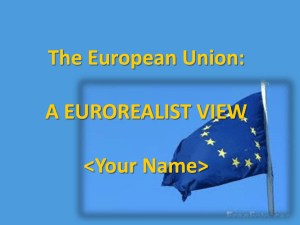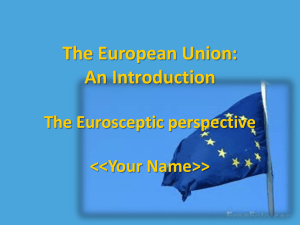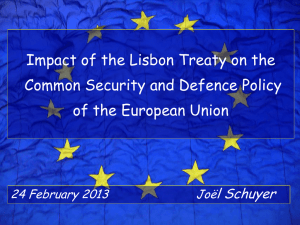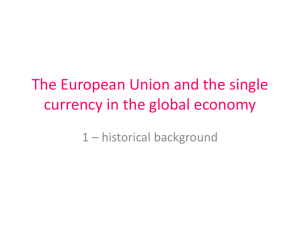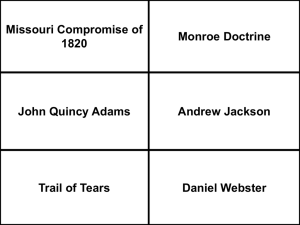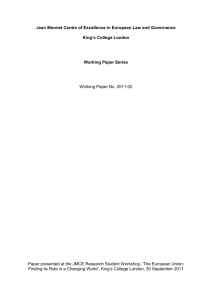The Lisbon Treaty and its Implications for civil society
advertisement
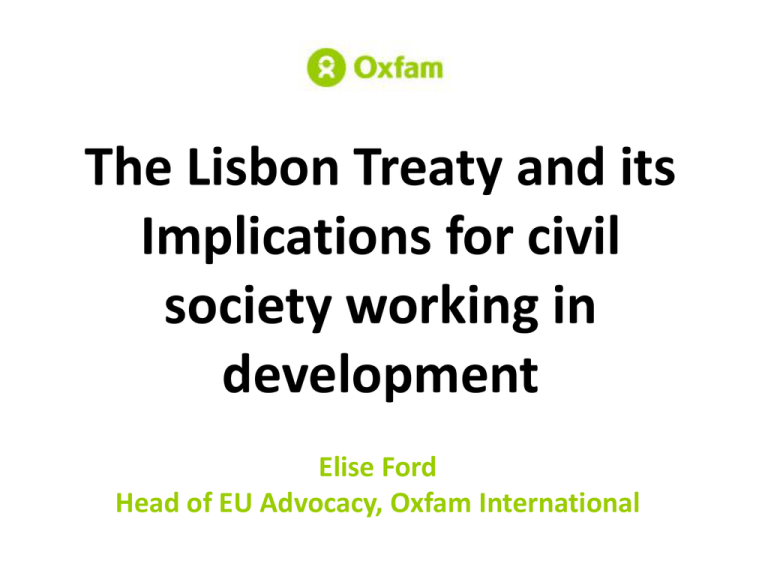
The Lisbon Treaty and its Implications for civil society working in development Elise Ford Head of EU Advocacy, Oxfam International Structure of the session 1. Lisbon Treaty: Changes in power - New roles - Changing power relations between institutions 2. Lisbon Treaty: Changes in policies & policy-making - Provisions on development policy under Lisbon - Structure of EAS and impact on EU’s external policies SECTION 1 LISBON TREATY: CHANGES IN POWER 7 MAJOR CHANGES IN POWERS UNDER LISBON… 1. 2. 3. 4. 5. 6. 7. A President of Europe A European “Foreign Minister” European Delegations Europe has a legal personality Council has more consensus Parliaments increase powers Citizens have a direct way to have a say 1. Europe has a President WHAT DOES A PRESIDENT DO? THE THEORY… N.B. President of European Council. It’s not the same as President of Europe Tasks • To chair and drive forward the work of the European Council • To ensure the preparation and continuity of the work of the European Council in cooperation with the President of the Commission, and on the basis of the work of the General Affairs Council (GAC); • To facilitate cohesion and consensus within the European Council; • To present a report to the European Parliament after each of the meetings of the European Council. The President can also, at his level and in that capacity, ensure the external representation of the Union on issues concerning its common foreign and security policy, without prejudice to the powers of the High Representative for Foreign Affairs and Security Policy. The President will also convene meetings of the European Council at least four times a year, and he possesses the formal power to convene a Convention to amend the EU treaties WHAT DOES A PRESIDENT DO? THE PRACTICE… • Europe chose a “Herman Van Rompuy” – Facilitator rather than leader, informal & consensus-building • European Councils are taking place frequently – era of the leaders – Not just 4 times a year – Extraordinary Councils for crises, informal Councils for discussion, high level Summits • Policy focus so far internal – Priority economic governance • Good relations with Mr. Barroso – weekly meetings • Relations with HR unclear – interest on foreign policy? • EP speech = State of the Union? 2. Europe has a Foreign Minister WHAT DOES A FOREIGN MINISTER/HIGH REP DO? THE THEORY (I)… ANSWER: MUCH MORE THAN SOLANA 3 ROLES ROLLED INTO ONE - High Representative - Rotating Presidency (Foreign Minister) - Commissioner for External Relations + She has to set up her own office (EAS) THE THEORY (II)… • Conducts the Union's common foreign and security policy • Contributes by her proposals to the development of that policy, which she will carry out as mandated by the Council, and ensures implementation of the decisions adopted in this field • Presides over the Foreign Affairs Council (and thus sets the agenda) • Is one of the Vice-Presidents of the Commission & ensures the consistency of the Union's external action. • Represents the Union for matters relating to the common foreign and security policy, conduct political dialogue with third parties on the Union's behalf & expresses its position in international organisations / conferences. • Exercises authority over the European External Action Service and over the Union delegations THE PRACTICE… • Struggle to combine three posts • EU Foreign Policy – media expectation too high, too little margin from MS • Battle between Presidency & High Rep for FAC control • Internal EC coordination – she heads up External Commissioners • EAS – big turf-war, big distraction, impeding analytical/propositional capacity • External Representation is a messy picture WHO REPRESENTS THE UNION? 3. Europe has Embassies What is role & function of the EAS? (I) Article 27(3) TEU constitutes the legal basis for the Council decision on the organisation and functioning of the EEAS. “In fulfilling his mandate, the High Representative shall be assisted by a European External Action Service. This service shall work in cooperation with the diplomatic services of the Member States and shall comprise officials from relevant departments of the General Secretariat of the Council and of the Commission as well as staff seconded from national diplomatic services of the member states.” What is role & function of the EAS? (II) BASIC FUNCTIONS – The EEAS will be sui generis institution. Will it be attached to European Commission? – It will be paid for by EU budget. – The EEAS will help the High Representative ensure the consistency and coordination of the Union's external action as well as prepare policy proposals and implement them after their approval by Council. – It shall also support and assist other EU institutions. – The EEAS should be composed of single geographical (covering all regions and countries) and thematic desks, which will continue to perform under the authority of the High Representative the tasks currently executed by the relevant parts of the Commission and the Council Secretariat. – The EU’s crisis management structures shall be integrated into the service. – Trade and development policy as defined by the Treaty should remain the responsibility of relevant Commissioners of the Commission although the EAS may have some coordinating capacity. What is role & function of the EAS? (III) THE DELEGATIONS – The Commission's delegations will become Union delegations under the authority of the High Representative and will be part of the EEAS structure. – Delegations will contain both regular EEAS staff (including Heads of Delegation) and staff from relevant Commission services. – EU delegations will work in close cooperation with diplomatic services of the Member States.. – They should play a supporting role as regards diplomatic and consular protection of Union citizens in third countries. They will not have their own consular powers – Work on Delegations will be supported by Special Representatives to deal with regional dynamics. 4. Europe has a (legal) personality “On 1 December 2009 the European Community was replaced by the European Union which succeeds it and takes over all its rights and obligations. The Treaty on European Union keeps the same name and the Treaty establishing the European Community becomes the Treaty on the Functioning of the European Union” WHAT DOES IT MEAN? The EU able to represent Europe, sign treaties, go to and be summoned to court, and become a member of international organisations. Greater clarity in relations with the rest of the world, increased effectiveness and legal certainty and more effective action. 5. Consensus rules in Council - Up to now, when the Council voted on the basis of a qualified majority, the number of votes attributed to each Member State was predetermined by the Treaty itself (applying a scale ranging from 29 votes each for the four largest Member States to 3 votes for the smallest). - Nov 2014 Definition of the qualified majority changes - it will then be a double majority - support of at least 55 % of the EU Member States (i.e. 15/27) - at least 65 % of the population of the EU. - a blocking minority must include at least four Member States. (Until March 2017, can request previous system) - Also, more decisions made on basis of QMV - Council obliged to meet in public when deliberates & votes on European legislation. 6. (European) Parliament has (more) power EP: More powers, more responsibility? - Over 40 new fields under co-decision - including agriculture, energy policy, immigration and EU funds. - On trade, codecision on trade legislation (e.g. GSP), consent on agreements, and reports on negotiations (n.b. no direct say in negotiations) - Power over foreign policy/development in negotiation with EAS - Bigger role in setting budgets (old distinction between "compulsory" and "non-compulsory" expenditure is abolished. Parliament will decide on the entire EU budget together with the Council and has final say - Powers on Financial Perspectives potentially reduced. 6. (bis) National parliaments 1. National parliaments will have eight weeks to examine draft European legislative acts. If a third of them (a quarter in the field of Justice and Home Affairs) oppose a draft, the Commission must review it. 2. If over half of all national parliaments oppose an act subject to codecision, the European legislator (a majority of the European Parliament or 55 % of the votes in the Council) must decide whether or not to proceed with the legislative process. 3. National parliaments may also take a case to the European Court of Justice if they consider that a legislative act is contrary to theprinciple of subsidiarity. 7. Citizen’s Initiative A million citizens may sign a petition inviting the Commission to submit a proposal on any area of EU competence…. EC Green Paper (Jan 2010) Legislation http://ec.europa.eu/dgs/secretariat_general/citizens_initiative/docs/com_2009_ 622_en.pdf) Ten issues 1. Minimum number of Member States 2. Minimum number of signatures per Member State 3. Eligibility to support (minimum age) 4. Form and wording of ECI 5. Requirements for collection & atuthetification of signatures 6. Time limit for collection 7. Registration of proposed initiatives 8. Requirements for organizers 9. Examination of citizens’ initiatives by the EC 10. Initiatives on same issue 7 MAJOR CHANGES IN POWERS UNDER LISBON… 1. 2. 3. 4. 5. 6. 7. A President of Europe A European “Foreign Minister” European Delegations Europe has a legal personality Council has more consensus Parliaments increase powers Citizens have a direct way to have a say WINNERS & LOSERS - WHO HAS THE POWER? - HOW TO INFLUENCE? Conclusions & lessons • Simultaneous trends towards “federalism” & “intergovernmentalism” • Diminishing faith in EU political system – Lisbon rejection, Stablity & Growth Pact • Increasing Bxl-based power does not mean increased Bxlbased influencing – National influencing still has the biggest impact – Regardless of institution, individuals driven by individual interests/approaches – Knowledge of Bxl context can put you fully ahead of the game • • • • Dominance of Summits v Council – Member States politics MEPs part of same trend Presidencies on the wane – agenda-setting, visibility Moment of change – moment for maximalist influence… Policies & direction of policies SECTION 2 LISBON TREATY: CHANGES IN POLICIES & POLICYMAKING The Lisbon Treaty & Development Policy • • • • • The Treaty of Lisbon clearly states that the reduction and the eradication of poverty is the primary objective of the Union’s development cooperation policy. This goal must be respected when the Union implements policies likely to affect developing countries. This implies also that development policy is a policy in its own right, and not an accessory of common foreign and security policy. Policy Coherence for Development is also an explicit obligation within the Treaties. The Treaty of Lisbon introduces for the first time a specific legal basis for humanitarian aid. This provision stresses the specificity of the policy and the application of the principles of international humanitarian law, in particular impartiality and non-discrimination. In case of urgent financial aid, the Council will act by qualified majority upon a proposal from the Commission. This should mean quicker financial aid in the future. The Treaty of Lisbon classifies development cooperation and humanitarian aid as “shared parallel competences”: this means that the Union conducts an autonomous policy, which neither prevents the Member States from exercising their competences nor makes the Union’s policy merely “complementary” to those of the Member States. 21st Century European External Action Service What does Ashton say? “ The aim of the Lisbon Treaty and the creation of the External Action Service is to enhance our global impact, by bringing together the wide range of instruments - civilian and military - in support of one political strategy. The watchwords are coherence, comprehensiveness and coordination. " EAS – a system in flux What did Lisbon say? V little detail on External Action Service. Additional elements to be agreed by Member States upon proposal by High Representative in agreement with European Commission Institutional battle ensured Positions EC preserving community method/foreign policy control Council – safeguarding national prerogatives, promoting a maximally functional service EP democratic oversight (why does it matter?) No agreement to date… Key reference documents 1. October Council Decision 2009 - setting parameters for subsequent decisions 2. April 26th 2010 Council Agreement – Member States positions 3. Draft EP Report – EP’s position What we know (I) EAS Organigramme • Ashton heads up External Relations Cluster within Commission • EAS under her authority • 3 political director (Administrative, Political) • Permanent chair of PSC • Single geographical desks • Civil-Military Elements Integrated • Development Directorate • Horizontal units • EAS responsible for all Delegations • Budget neutral/funds from EC budget • Staffed 1/3 EC, 1/3 Council, 1/3 Member States Staff Transfers - Council 1. GENERAL SECRETARIAT OF THE COUNCIL All staff in the departments and functions listed below shall be transferred en bloc to the EEAS, except for a very limited number of staff to perform the normal tasks of the General Secretariat of the Council in line with Article 2(1), second indent, and for certain specific functions which are indicated below: Policy Unit · ESDP and crisis management structures Crisis Management and Planning Directorate (CMPD) Civilian Planning and Conduct Capability (CPCC) European Union Military Staff (EUMS) Departments under the direct authority of DGEUMS Concepts and Capability Directorate Intelligence Directorate Operations Directorate Logistics Directorate Communications and Information Systems Directorate EU Situation Centre (SITCEN) Exception: Staff in the SITCEN supporting the Security Accreditation Authority · · · · · · · Directorate-General E Entities placed under the direct authority of the Director-General Directorate for the Americas and the United Nations Directorate for the Western Balkans, Eastern Europe and Central Asia Directorate for Non-Proliferation of Weapons of Mass Destruction Directorate for Parliamentary affairs in the area of CFSP New York Liaison Office Geneva Liaison Office · · · o o o o o o · GSC officials on secondment to European Union Special Representatives and CSDP missions. Staff Transfers - Commission 2. COMMISSION (INCLUDING DELEGATIONS) · · · · · · · · · · · · · · Directorate-General for External Relations All hierarchy posts Directorate A (Crisis Platform and policy coordination in CFSP) Directorate B (Multilateral Relations and Human Rights) Directorate C (North America, East Asia, Australia, New Zealand, EEA, EFTA, San Marino, Andorra, Monaco) Directorate D (European Neighbourhood Policy Coordination) Directorate E (Eastern Europe, Southern Caucasus, Central Asia Republics) Directorate F (Middle East, South Mediterranean) Directorate G (Latin America) Directorate H (Asia (except Japan and Korea)) Directorate I (Headquarters resources, information, inter-institutional relations) Directorate K (External Service) Directorate L (Strategy, Coordination and Analysis) Task Force on the Eastern Partnership Unit Relex-01 (audit) · · Exceptions: Staff responsible for the management of financial instruments Staff responsible for the payment of salaries and allowances to staff in delegations · · · · External Service All Heads of Delegation and Deputy Heads of Delegation All Political Sections and staff All information and public diplomacy sections and staff All Administration sections · Exceptions Staff responsible for the implementation of financial instruments · · · · · Directorate-General for Development Directorate D (ACP II – West and Central Africa, Caribbean and OCT) except OCT task force Directorate E (Horn of Africa, East and Southern Africa, Indian Ocean and Pacific) Unit CI (ACP I: Aid programming and management): Staff responsible for programming Unit C2 (Pan-African issues and institutions, governance and migration): Staff responsible for Pan-African relations Applicable hierarchy posts What we know (II) Roles of EU Delegations Role EC Delegation + Presidency combined – Convening coordination meetings of EU member states’ embassies – Local representation of the EU in matters pertaining to CFSP and CSDP. – Heads of delegation will also be empowered to speak on behalf of the EU as a whole – Financial powers? – Crisis management structures? – Consular powers Timetable By the end of the Spanish presidency, approx 50% of Delegations will be under EAS structures. To be completed by Belgian Presidency. What is still at stake? (I) Where programming of external assistance instruments sits? DCI, EDP, ENPI, EIDHR - not including humanitarian aid, trade Three positions 1. Fully under EAS control 2. Fully under Development Commissioner control 3. Mixed control c.f. EP amendment under discussion “Strategic programming of external assistance instruments should be done jointly by the EEAS and the services of the competent Commissioners. Proposals for higher-level programming documents* under these instruments will be agreed jointly by the HRVP and the competent Commissioner(s) and presented to the College of Commissioners for the final decision. In case of a disagreement between the HRVP and the competent Commissioner, the decision will be made by the College of Commissioners. For all these instruments, lower-level programming and implementation will be carried out by the services responsible to the competent Commissioner.” A brief introduction to EC programming… 1. Country Allocation 2. Country Strategy Papers 3. Multiannual programming 4. Annual Programming 5. Implementation PRE LISBON • Development instruments split – EDF = DG DEV, DCI = RELEX phases 1-3 • AidCo responsible for 4-5 EDF + DCI • No role for High Representative Possible models under Lisbon… Ashton proposal EC proposal EP proposal 1. Country Allocation 1. Country Allocation 1. Country Allocation 2. Country Strategy Papers 2. Country Strategy Papers 2. Country Strategy Papers 3. Multiannual programming 3. Multiannual programming 3. Multiannual programming 4. Annual Programming 4. Annual Programming 4. Annual Programming 5. Implementation 5. Implementation 5. Implementation All phases: HR+EC joint All phases: EC only Phases 1-3: Joint (or 1-2) Phases 4-5: EC only So what…? • Efficient policy-making – Greater alignment between development policymaking and implementation – Universal approach to policy-making across countries – Neighbourhood, ACP, ALA • Exceptionalism towards development aid vis-àvis trade/humanitarian • Politicisation of aid agenda – strongly linked to aid effectiveness agenda – Development aid is a tool of foreign policy – Sometimes FP interests will come second • Development aid funding collective European action approaches (rather than political alignment) • Diminishing development expertise? What is still at stake? (II) • What type of development policy? What do “poverty eradication” and “policy coherence for development” commitments really mean? • Increase coherence, consistency, capabilities and visibility? – – – – – Which policies under EAS? Policy coherence with what and for what? Will all capabilities be integrated? What power struggle between HR and Presidencies? Will MS really give HR space to formulate common European foreign policies? • What type of European diplomacy? • Increased impact? N.B. Reviews to take place at end of 2011 & 2013. Further reading • Centre for European Policy Studies: www.ceps.eu Lisbon five months on: Surveying the new EU political scene www.ceps.eu/book/lisbon-five-months-surveying-new-eu-political-scene What kind of political actor will the Lisbon EU be? www.ceps.eu/book/capital-brussels-what-kind-political-actor-will-lisbon-eu-be • EAS Rewriting the ground rules of European diplomacy - Timo Behr, Aaretti Siitonen and Johanna Nykänen (Finnish Institute of International Relations) www. • Trade Policy under Lisbon Aprodev - Lisbon Treaty and impact on EU Trade Policy www.aprodev.net/main/Files/APRODEV%20Brief%20Impact%20of%20Lisbon %20Treaty%20on%20EU%20Trade%20Policy.pdf

